The Determining Influence of the Phase Composition on the Mechanical Properties of Titanium—Iron Alloys after High-Pressure Torsion
Abstract
:1. Introduction
2. Materials and Methods
3. Experimental Results
3.1. Microstructures and Phase Composition of Samples before and after HPT
3.2. Characterization of the Microstructure of HPT-Processed Samples Using a TEM
3.3. Nanoindentation and Microhardness of Samples after HPT
4. Discussion
5. Conclusions
Author Contributions
Funding
Institutional Review Board Statement
Informed Consent Statement
Data Availability Statement
Acknowledgments
Conflicts of Interest
References
- Valiev, R.Z.; Alexandrov, I.V.; Islamgaliev, R.K. Processing and Properties of Nanostructured Materials Prepared by Severe Plastic Deformation. In Nanostructured Materials; Chow, G.M., Noskova, N.I., Eds.; NATO ASI Series Springer: Dordrecht, The Netherlands, 1998; Volume 50. [Google Scholar] [CrossRef]
- Valiev, R.Z.; Korznikov, A.V.; Mulyukov, R.R. Structure and properties of ultrafine-grained materials produced by severe plastic deformation. Mater. Sci. Eng. A 1993, 168, 141–148. [Google Scholar] [CrossRef]
- Edalati, K.; Matsubara, E.; Horita, Z. Processing pure Ti by high-pressure torsion in wide ranges of pressure and strain. Metall. Mater. Trans. A 2009, 40, 2079–2086. [Google Scholar] [CrossRef]
- Edalati, K.; Daio, T.; Arita, M.; Lee, S.; Horita, Z.; Togo, A.; Tanaka, I. High pressure torsion of titanium at cryogenic and room temperatures: Grain size effect on allotropic phase transformation. Acta Mater. 2014, 68, 207–213. [Google Scholar] [CrossRef]
- Deng, G.Y.; Bhattacharjee, T.; Chong, Y.; Zheng, R.; Bai, Y.; Shibata, A.; Tsuji, N. Characterization of microstructure with different Fe addition processed by severe plastic deformation and subsequent annealing. IOP Conf. Ser. Mater. Sci. Eng. 2017, 194, 012020. [Google Scholar] [CrossRef]
- Wang, C.T.; Fox, A.G.; Langdon, T.G. Microstructural evolution in ultrafine-grained titanium processed by high-pressure torsion under different pressures. J. Mater. Sci. 2014, 49, 6558–6564. [Google Scholar] [CrossRef]
- Sinha, S.; Sahu, V.K.; Beura, V.; Sonkusare, R.; Kalsar, R.; Das, A.K.L.; Basu, J.; Gurao, N.P.; Biswas, K. Initial texture dependence of nanocrystalline omega phase formation during high pressure torsion of commercially pure titanium. Mater. Sci. Eng. A 2021, 802, 140687. [Google Scholar] [CrossRef]
- Zaher, G.; Lomakin, I.; Enikeev, N.; Jouen, S.; Saiter-Fourcin, A.; Sauvage, X. Influence of strain rate and Sn in solid solution on the grain refinement and crystalline defect density in severely deformed Cu. Mater. Today Comm. 2021, 26, 101746. [Google Scholar] [CrossRef]
- Edalati, K.; Wang, Q.; Enikeev, N.A.; Peters, L.J.; Zehetbauer, M.J.; Schafler, E. Significance of strain rate in severe plastic deformation on steady-state microstructure and strength. Mater. Sci. Eng. A 2022, 859, 144231. [Google Scholar] [CrossRef]
- Lin, H.K.; Cheng, Y.H.; Li, G.Y.; Chen, Y.C.; Bazarnik, P.; Muzy, J.; Huang, Y.; Langdon, T.G. Study on the surface modification of nanostructured Ti alloys and coarse-grained Ti alloys. Metals 2022, 12, 948. [Google Scholar] [CrossRef]
- Figueiredo, R.B.; Langdon, T.G. Deformation mechanisms in ultrafine-grained metals with an emphasis on the Hall–Petch relationship and strain rate sensitivity . J. Mater. Res. Technol. 2021, 14, 137–159. [Google Scholar] [CrossRef]
- Islamgaliev, R.K.; Kazyhanov, V.U.; Shestakova, L.O.; Sharafutdinov, A.V.; Valiev, R.Z. Microstructure and mechanical properties of titanium (Grade 4) processed by high-pressure torsion. Mater. Sci. Eng. A 2008, 493, 190–194. [Google Scholar] [CrossRef]
- Sotniczuk, A.; Garbacz, H. Nanostructured bulk titanium with enhanced properties—Strategies and prospects for dental applications. Adv. Eng. Mater. 2021, 23, 2000909. [Google Scholar] [CrossRef]
- Chen, W.J.; Xu, J.; Liu, D.T.; Bao, J.X.; Sabbaghianrad, S.; Shan, D.B.; Guo, B.; Langdon, T.G. Microstructural evolution and microhardness variations in pure titanium processed by high-pressure torsion. Adv. Eng. Mater. 2020, 22, 1901462. [Google Scholar] [CrossRef]
- Li, H.; Zhang, W.C.; Yang, J.L.; Pan, J.Q.; Chen, W.Z.; Cui, G.R.; Wang, G.F.; Chu, G.N. Microstructural evolution and mechanical properties of Ti-22Al-25Nb alloy fabricated by high-pressure torsion under ageing treatment. J. Mater. Eng. Perform. 2022, 31, 07465. [Google Scholar] [CrossRef]
- Bazarnik, P.; Bartkowska, A.; Huang, Y.; Szlazak, K.; Adamczyk-Cieslak, B.; Sort, J.; Lewandowska, M.; Langdon, T.G. Fabrication of hybrid nanocrystalline Al–Ti alloys by mechanical bonding through high-pressure torsion. Mater. Sci. Eng. A 2022, 833, 142549. [Google Scholar] [CrossRef]
- Liss, K.D.; Liu, X.J.; Li, X.; Han, J.K.; Dippenaar, R.J.; Kawasaki, M. On the thermal evolution of high-pressure torsion processed titanium aluminide. Mater. Lett. 2021, 304, 130650. [Google Scholar] [CrossRef]
- Bartkowska, A.; Bazarnik, P.; Huang, Y.; Lewandowska, M.; Langdon, T.G. Using high-pressure torsion to fabricate an Al–Ti hybrid system with exceptional mechanical properties. Mater. Sci. Eng. A 2021, 799, 140114. [Google Scholar] [CrossRef]
- Han, J.K.; Li, X.; Dippenaar, R.; Liss, K.D.; Kawasaki, M. Microscopic plastic response in a bulk nano-structured TiAl intermetallic compound processed by high-pressure torsion. Mater. Sci. Eng. A 2018, 714, 84–92. [Google Scholar] [CrossRef]
- Cao, G.H.; Russell, A.M.; Oertel, C.G.; Skrotzki, W. Microstructural evolution of TiAl-based alloys deformed by high-pressure torsion. Acta Mater. 2015, 98, 103–112. [Google Scholar] [CrossRef]
- Edalati, K.; Ashida, M.; Horita, Z.; Matsui, T.; Kato, H. Wear resistance and tribological features of pure aluminum and Al–Al2O3 composites consolidated by high-pressure torsion. Wear 2014, 310, 83–89. [Google Scholar] [CrossRef]
- Edalati, K.; Iwaoka, H.; Horita, Z.; Tanaka, M.; Higashida, K.; Fujiwara, H.; Ameyama, K. Fabrication of ultrafine-grained Ti-(5-50 wt.%) Al2O3 composites using high-pressure torsion. Kovové Mater. Metal. Mater. 2011, 49, 85–91. [Google Scholar] [CrossRef]
- Cao, G.H.; Kloeden, B.; Rybacki, E.; Oertel, C.G.; Skrotzki, W. High strain torsion of a TiAl-based alloy. Mater. Sci. Eng. A 2008, 483–484, 512–516. [Google Scholar] [CrossRef]
- Cao, G.H.; Skrotzki, W.; Gemming, T. Transmission electron microscopy investigation of Ti2Al precipitation in titanium aluminides during high-strain torsion. J. Alloys Compd. 2006, 417, 169–172. [Google Scholar] [CrossRef]
- Oh, S.H.; Kiener, D. Synthesis and mechanical characterisation of an ultra-fine grained Ti-Mg composite. Materials 2016, 9, 688. [Google Scholar] [CrossRef]
- Edalati, K.; Emami, H.; Staykov, A.; Smith, D.J.; Akiba, E.; Horita, Z. Formation of metastable phases in magnesium–titanium system by high-pressure torsion and their hydrogen storage performance. Acta Mater. 2015, 99, 150–156. [Google Scholar] [CrossRef]
- Deng, G.; Bhattacharjee, T.; Chong, Y.; Zheng, R.X.; Bai, Y.; Shibata, A.; Tsuji, N. Influence of Fe addition in CP titanium on phase transformation, microstructure and mechanical properties during high pressure torsion. J. Alloys Compd. 2020, 822, 153604. [Google Scholar] [CrossRef]
- Gurau, G.; Gurau, C.; Braz Fernandes, F.M.; Alexandru, P.; Sampath, V.; Marin, M.; Galbinasu, B.M. Structural characteristics of multilayered Ni-Ti nanocomposite fabricated by high speed high pressure torsion (HSHPT). Metals 2020, 10, 1629. [Google Scholar] [CrossRef]
- Sundeev, R.V.; Glezer, A.M.; Shalimova, A.V. Are the abilities of crystalline alloys to amorphization upon melt quenching and severe plastic deformation identical or different? Mater. Lett. 2016, 175, 72–74. [Google Scholar] [CrossRef]
- Resnina, N.; Belyaev, S.; Zeldovich, V.; Pilyugin, V.; Frolova, N.; Glazova, D. Variations in martensitic transformation parameters due to grains evolution during post-deformation heating of Ti-50.2 at.% Ni alloy amorphized by HPT. Therm. Acta 2016, 627–629, 20–30. [Google Scholar] [CrossRef]
- Shri, D.N.A.; Tsuchiya, K.; Yamamoto, A. Cytocompatibility evaluation and surface characterization of TiNi deformed by high-pressure torsion. Mater. Sci. Eng. C 2014, 43, 411–417. [Google Scholar] [CrossRef] [PubMed]
- Shri, D.N.A.; Tsuchiya, K.; Yamamoto, A. Effect of high-pressure torsion deformation on surface properties and biocompatibility of Ti-50.9 mol. %Ni alloys. Biointerphases 2014, 9, 029007. [Google Scholar] [CrossRef]
- Shri, D.N.A.; Tsuchiya, K.; Yamamoto, A. Surface characterization of TiNi deformed by high-pressure torsion. Appl. Surf. Sci. 2014, 289, 338–344. [Google Scholar] [CrossRef]
- Pushin, V.G.; Kuranova, N.N.; Kourov, N.I.; Valiev, R.Z.; Korolev, A.V.; Makarov, V.V.; Pushin, A.V.; Uksusnikov, A.N. Effect of heat treatment on structural and phase transformations in the Ti49.5Ni50.5 alloy amorphized by high-pressure torsion. Phys. Met. Metallogr. 2013, 114, 488–502. [Google Scholar] [CrossRef]
- Mahesh, K.K.; Braz Fernandes, F.M.; Gurau, G. Stability of thermal-induced phase transformations in the severely deformed equiatomic Ni–Ti alloys. J. Mater. Sci. 2012, 47, 6005–6014. [Google Scholar] [CrossRef]
- Pushin, V.G.; Valiev, R.Z.; Kourov, N.I.; Kuranova, N.N.; Makarov, V.V.; Pushin, A.V.; Uksusnikov, A.N. Phase and structural transformations in the Ti49.5Ni50.5 alloy with a shape-memory effect during torsion under high pressure. Phys. Met. Metallogr. 2012, 113, 256–270. [Google Scholar] [CrossRef]
- Kourov, N.I.; Pushin, V.G.; Korolev, A.V.; Kazantsev, V.A.; Knyazev, Y.V.; Kuranova, N.N. Effect of plastic deformation on physical properties and structure of the shape memory alloy Ti49.5Ni50.5. Phys. Sol. State 2011, 53, 1397–1403. [Google Scholar] [CrossRef]
- Singh, R.; Divinski, S.V.; Roesner, H.; Prokofiev, E.A.; Valiev, R.Z.; Wilde, G. Microstructure evolution in nanocrystalline NiTi alloy produced by HPT. J. Alloys Compd. 2011, 509, S290–S293. [Google Scholar] [CrossRef]
- Singh, R.; Divinski, S.V.; Roesner, H.; Prokofiev, E.A.; Valiev, R.Z.; Wilde, G. Annealing behaviour of nanocrystalline NiTi (50 at% Ni) alloy produced by high-pressure torsion. Phil. Mag. 2011, 91, 3079–3092. [Google Scholar] [CrossRef]
- Surikova, N.S.; Klopotov, A.A.; Korznikova, E.A. Mechanisms of plastic deformation in microcrystalline and nanocrystalline TiNi-based alloys. Phys. Met. Metallogr. 2010, 110, 269–278. [Google Scholar] [CrossRef]
- Gunderov, D.V.; Kuranova, N.N.; Luk’yanov, A.V.; Uksusnikov, A.N.; Prokof’ev, E.A.; Yurchenko, L.I.; Valiev, R.Z.; Pushin, V.G. Application of severe plastic deformation by torsion to form amorphous and nanocrystalline states in large-size TiNi alloy sample. Phys. Met. Metallogr. 2009, 108, 131–138. [Google Scholar] [CrossRef]
- Valiev, R.; Gunderov, D.; Prokofiev, E.; Pushin, V.; Zhu, Y. Nanostructuring of TiNi alloy by SPD processing for advanced properties. Mater. Trans. 2008, 49, 97–101. [Google Scholar] [CrossRef]
- Pushin, V.G.; Valiev, R.Z.; Zhu, Y.T.; Gunderov, D.V.; Kourov, N.I.; Kuntsevich, T.E.; Uksusnikov, A.N.; Yurchenko, L.I. Effect of severe plastic deformation on the behavior of Ti–Ni shape memory alloys. Mater. Trans. 2006, 47, 694–697. [Google Scholar] [CrossRef]
- Prokoshkin, S.D.; Khmelevskaya, I.Y.; Dobatkin, S.V.; Trubitsyna, I.B.; Tatyanin, E.V.; Stolyarov, V.V.; Prokofiev, E.A. Alloy composition, deformation temperature, pressure and post-deformation annealing effects in severely deformed Ti–Ni based shape memory alloys. Acta Mater. 2005, 53, 2703–2714. [Google Scholar] [CrossRef]
- Sergueeva, A.V.; Stolyarov, V.V.; Valiev, R.Z.; Mukherjee, A.K. Advanced mechanical properties of pure titanium with ultrafine grained structure. Scr. Mater. 2001, 45, 747–752. [Google Scholar] [CrossRef]
- Bartha, K.; Strasky, J.; Veverkova, A.; Vesely, J.; Cizek, J.; Malek, J.; Polyakova, V.; Semenova, I.; Janecek, M. Phase Transformations upon ageing in Ti15Mo alloys to two different deformation methods. Metals 2021, 11, 1230. [Google Scholar] [CrossRef]
- Jiang, B.Z.; Emura, S.; Tsuchiya, K. Effect of quasi-hydrostatic pressure on deformation mechanism in Ti-10Mo alloy. Metals 2020, 10, 1387. [Google Scholar] [CrossRef]
- Bartha, K.; Strasky, J.; Veverkova, A.; Barriobero-Vila, P.; Lukac, F.; Dolezal, P.; Sedlak, P.; Polyakova, V.; Semenova, I.; Janecek, M. Effect of the high-pressure torsion (HPT) and subsequent isothermal annealing on the phase transformation in biomedical Ti15Mo alloy. Metals 2019, 9, 1194. [Google Scholar] [CrossRef]
- Bartha, K.; Strasky, J.; Harcuba, P.; Semenova, I.; Polyakova, V.; Janecek, M. Heterogeneous precipitation of the α-phase in Ti15Mo alloy subjected to high pressure torsion. Acta Phys. Pol. A 2018, 134, 790–793. [Google Scholar] [CrossRef]
- Afonso, C.R.M.; Amigo, A.; Stolyarov, V.; Gunderov, D.; Amigo, V. From porous to dense nanostructured β-Ti alloys through high-pressure torsion. Sci. Rep. 2017, 7, 13618. [Google Scholar] [CrossRef]
- Vaclavova, K.; Strasky, J.; Polyakova, V.; Straska, J.; Nejezchlebova, J.; Seiner, H.; Semenova, I.; Janecek, M. Microhardness and microstructure evolution of ultra-fine grained Ti-15Mo and TIMETAL LCB alloys prepared by high pressure torsion. Mater. Sci. Eng. A 2017, 682, 220–228. [Google Scholar] [CrossRef]
- Zafari, A.; Wei, X.S.; Xu, W.; Xia, K. Formation of nanocrystalline β structure in metastable beta Ti alloy during high pressure torsion: The role played by stress induced martensitic transformation. Acta Mater. 2015, 97, 146–155. [Google Scholar] [CrossRef]
- Jiang, B.Z.; Tsuchiya, K.; Emura, S.; Min, X.H. Effect of high-pressure torsion process on precipitation behavior of α phase in β-type Ti–15Mo alloy. Mater. Trans. 2014, 55, 877–884. [Google Scholar] [CrossRef]
- Xu, W.; Edwards, D.P.; Wu, X.; Stoica, M.; Calin, M.; Kuehn, U.; Eckert, J.; Xia, K. Promoting nano/ultrafine-duplex structure via accelerated α precipitation in a β-type titanium alloy severely deformed by high-pressure torsion. Scr. Mater. 2013, 68, 67–70. [Google Scholar] [CrossRef]
- Cvijovic-Alagic, I.; Laketic, S.; Bajat, J.; Hohenwarter, A.; Rakin, M. Grain refinement effect on the Ti-45Nb alloy electrochemical behavior in simulated physiological solution. Surf. Coat. Technol. 2021, 423, 127609. [Google Scholar] [CrossRef]
- Laketic, S.; Rakin, M.; Momcilovic, M.; Ciganovic, J.; Veljovic, D.; Cvijovic-Alagic, I. Influence of laser irradiation parameters on the ultrafine-grained Ti-45Nb alloy surface characteristics. Surf. Coat. Technol. 2021, 418, 127255. [Google Scholar] [CrossRef]
- Cvijovic-Alagic, I.; Rakin, M.; Laketic, S.; Zagorac, D. Microstructural study of Ti-45Nb alloy before and after HPT processing using experimental and ab initio data mining approach. Mater. Charact. 2020, 169, 110635. [Google Scholar] [CrossRef]
- Campos-Quiros, A.; Cubero-Sesin, J.M.; Edalati, K. Synthesis of nanostructured biomaterials by high-pressure torsion: Effect of niobium content on microstructure and mechanical properties of Ti-Nb alloys. Mater. Sci. Eng. A 2020, 795, 139972. [Google Scholar] [CrossRef]
- Barjaktarevic, D.; Medjo, B.; Stefane, P.; Gubeljak, N.; Cvijovic-Alagic, I.; Djokic, V.; Rakin, M. Tensile and corrosion properties of anodized ultrafine-grained Ti–13Nb–13Zr biomedical alloy obtained by high-pressure torsion. Metal. Mater. Int. 2021, 27, 3325–3341. [Google Scholar] [CrossRef]
- Voelker, B.; Maier-Kiener, V.; Werbach, K.; Mueller, T.; Pilz, S.; Calin, M.; Eckert, J.; Hohenwarter, A. Influence of annealing on microstructure and mechanical properties of ultrafine-grained Ti45Nb. Mater. Design 2019, 179, 107864. [Google Scholar] [CrossRef]
- Delshadmanesh, M.; Khatibi, G.; Ghomsheh, M.Z.; Lederer, M.; Zehetbauer, M.; Danninger, H. Influence of microstructure on fatigue of biocompatible β-phase Ti-45Nb. Mater. Sci. Eng. A 2017, 706, 83–94. [Google Scholar] [CrossRef]
- Voelker, B.; Jaeger, N.; Calin, M.; Zehetbauer, M.; Eckert, J.; Hohenwarter, A. Influence of testing orientation on mechanical properties of Ti45Nb deformed by high pressure torsion. Mater. Des. 2017, 114, 40–46. [Google Scholar] [CrossRef]
- Panigrahi, A.; Sulkowski, B.; Waitz, T.; Ozaltin, K.; Chrominski, W.; Pukenas, A.; Horky, J.; Lewandowska, M.; Skrotzki, W.; Zehetbauer, M. Mechanical properties, structural and texture evolution of biocompatible Ti–45Nb alloy processed by severe plastic deformation. J. Mech. Behav. Biomed. Mater. 2016, 62, 93–105. [Google Scholar] [CrossRef] [PubMed]
- Panigrahi, A.; Boenisch, M.; Waitz, T.; Schafler, E.; Calin, M.; Eckert, J.; Skrotzki, W.; Zehetbauer, M. Phase transformations and mechanical properties of biocompatible Ti–16.1Nb processed by severe plastic deformation. J. Alloys Compd. 2015, 628, 434–441. [Google Scholar] [CrossRef]
- Edalati, K.; Daio, T.; Lee, S.; Horita, Z.; Nishizaki, T.; Akune, T.; Nojima, T.; Sasaki, T. High strength and superconductivity in nanostructured niobium–titanium alloy by high-pressure torsion and annealing: Significance of elemental decomposition and supersaturation. Acta Mater. 2014, 80, 149–158. [Google Scholar] [CrossRef]
- Sulkowski, B.; Panigrahi, A.; Ozaltin, K.; Lewandowska, M.; Mikulowski, B.; Zehetbauer, M. Evolution of strength and structure during SPD processing of Ti–45Nb alloys: Experiments and simulations. J. Mater. Sci. 2014, 49, 6648–6655. [Google Scholar] [CrossRef]
- Dobromyslov, A.V.; Taluts, N.I.; Pilyugin, V.P. Severe plastic deformation by high-pressure torsion of Hf and Hf-Ti alloys. Int. J. Refr. Met. Hard Mater. 2020, 93, 105354. [Google Scholar] [CrossRef]
- Edalati, K.; Shao, H.; Emami, H.; Iwaoka, H.; Akiba, E.; Horita, Z. Activation of titanium-vanadium alloy for hydrogen storage by introduction of nanograins and edge dislocations using high-pressure torsion. Int. J. Hydr. Ener. 2016, 41, 8917–8924. [Google Scholar] [CrossRef]
- Oliver, W.C.; Pharr, G.M. Nanoindentation in materials research: Past, present, and future. MRS Bulletin 2010, 35, 897–907. [Google Scholar] [CrossRef]
- Niu, J.; Guo, Y.; Li, K.; Liu, W.; Dan, Z.; Sun, Z.; Chang, H.; Zhou, L. Improved mechanical, bio-corrosion properties and in vitro cell responses of Ti-Fe alloys as candidate dental implants. Mater. Sci. Eng. C 2021, 122, 111917. [Google Scholar] [CrossRef]
- Straumal, B.B.; Kilmametov, A.R.; Ivanisenko, Y.; Mazilkin, A.A.; Valiev, R.Z.; Afonikova, N.S.; Hahn, H. Diffusive and displacive phase transitions in Ti–Fe and Ti–Co alloys under high pressure torsion. J.Alloys Compd. 2018, 735, 2281–2286. [Google Scholar] [CrossRef]
- Chong, Y.; Deng, G.; Shibata, A.; Tsuji, N. Microstructure Evolution and Phase Transformation of Ti-1.0 wt%Fe Alloy with an Equiaxed α+β Initial Microstructure during High-Pressure Torsion and Subsequent Annealing. Adv. Eng. Mater. 2019, 21, 1900607. [Google Scholar] [CrossRef]
- Kilmametov, A.; Ivanisenko, Y.; Straumal, B.B.; Mazilkin, A.A.; Gornakova, A.S.; Kriegel, M.J.; Fabrichnaya, O.B.; Rafaja, D.; Hahn, H. Transformations of α’ martensite in Ti–Fe alloys under high pressure torsion. Scripta Mater. 2017, 136, 46–49. [Google Scholar] [CrossRef]
- Kilmametov, A.; Ivanisenko, Y.; Mazilkin, A.A.; Straumal, B.B.; Gornakova, A.S.; Fabrichnaya, O.B.; Kriegel, M.J.; Rafaja, D.; Hahn, H. The α→ω and β→ω phase transformations in Ti–Fe alloys under high-pressure torsion. Acta Mater. 2018, 144, 337–351. [Google Scholar] [CrossRef]
- Gornakova, A.S.; Straumal, B.B.; Nekrasov, A.N.; Kilmametov, A.; Afonikova, N.S. Grain boundary wetting by a second solid phase in Ti-Fe alloys. J. Mater. Eng. Perform. 2018, 27, 4989–4992. [Google Scholar] [CrossRef]
- Kriegel, M.J.; Kilmametov, A.; Klemm, V.; Schimpf, C.; Straumal, B.B.; Gornakova, A.S.; Ivanisenko, Y.; Fabrichnaya, O.; Hahn, H.; Rafaja, D. Thermal stability of athermal ω-Ti(Fe) produced upon quenching of β-Ti(Fe). Adv. Eng. Mater. 2019, 21, 1800158. [Google Scholar] [CrossRef]
- Kriegel, M.J.; Kilmametov, A.; Rudolph, M.; Straumal, B.B.; Gornakova, A.S.; Ivanisenko, Y.; Fabrichnaya, O.; Hahn, H.; Rafaja, D. Transformation pathway upon heating of Ti-Fe alloys deformed by high-pressure torsion. Adv. Eng. Mater. 2018, 20, 1700933. [Google Scholar] [CrossRef]
- Zavorotnev, Y.D.; Davdjan, G.C.; Varyukhin, V.N.; Petrenko, A.G.; Tomashevskaya, E.Y.; Straumal, B.B. Evolution of nanohardness of binary titanium-based solutions under high-pressure torsion. J. Surf. Inv. X-ray, Synch. Neutron Techn. 2024, 18, 660–665. [Google Scholar] [CrossRef]
- Straumal, B.B.; Kilmametov, A.R.; Mazilkin, A.A.; Gornakova, A.S.; Fabrichnaya, O.B.; Kriegel, M.J.; Rafaja, D.; Bulatov, M.F.; Nekrasov, A.N.; Baretzky, B. The formation of the omega phase in the titanium-iron system under shear deformation. JETP Lett. 2020, 111, 568–574. [Google Scholar] [CrossRef]
- Gornakova, A.S.; Straumal, B.B.; Mazilkin, A.A.; Afonikova, N.S.; Novikova, E.A.; Karpov, M.I.; Tyurin, A.I. Phase composition, nanohardness and Young’s modulus in Ti–Fe alloys after heat treatment and high pressure torsion. Metals 2021, 11, 1657. [Google Scholar] [CrossRef]
- Oliver, W.C.; Pharr, G.M. An improved technique for determining hardness and elastic modulus using load and displacement sensing indentation experiments. J. Mater. Res. 1992, 7, 1564–1583. [Google Scholar] [CrossRef]
- Oliver, W.C.; Pharr, G.M. Measurement of hardness and elastic modulus by instrumented indentation: Advances in understanding and refinements to methodology. J. Mater. Res. 2004, 19, 3–20. [Google Scholar] [CrossRef]
- Gornakova, A.S.; Straumal, B.B.; Golovin, Y.I.; Afonikova, N.S.; Pirozhkova, T.S.; Tyurin, A.I. Phase Transformations and mechanical properties of two-component titanium alloys after heat treatment in the two-phase region (α + intermetallic compound) and high-pressure torsion. J. Surf. Inv. X-ray Synch. Neut. Techn. 2021, 15, 1154–1158. [Google Scholar] [CrossRef]
- Kardashev, B.K.; Sapozhnikov, K.V.; Betekhtin, V.I.; Kadomtsev, A.G.; Narykova, M.V. Internal friction, Young’s modulus, and electrical resistivity of submicrocrystalline titanium. Phys. Sol. State 2017, 59, 2381–2386. [Google Scholar] [CrossRef]
- Kardashev, B.K.; Narykova, M.V.; Betekhtin, V.I.; Kadomtsev, A.G. Evolution of elastic properties of Ti and its alloys due to severe plastic deformation. Phys. Mesomech. 2020, 23, 193–198. [Google Scholar] [CrossRef]
- Qi, Y.; Kosinova, A.; Kilmametov, A.R.; Straumal, B.B.; Rabkin, E. Generation and healing of porosity in high purity copper by high-pressure torsion. Mater. Charact. 2018, 145, 1–9. [Google Scholar] [CrossRef]
- Koterov, A.N.; Ushenkova, L.N.; Zubenkova, E.S.; Kalinina, M.V.; Biryukov, A.P.; Lastochkina, E.M.; Molodtsova, D.V.; Vayison, A.A. The power of communication. Message 2. Gradations of the correlation value. Med. Radiol. Radiat. Saf. 2019, 64, 12–24. [Google Scholar] [CrossRef]
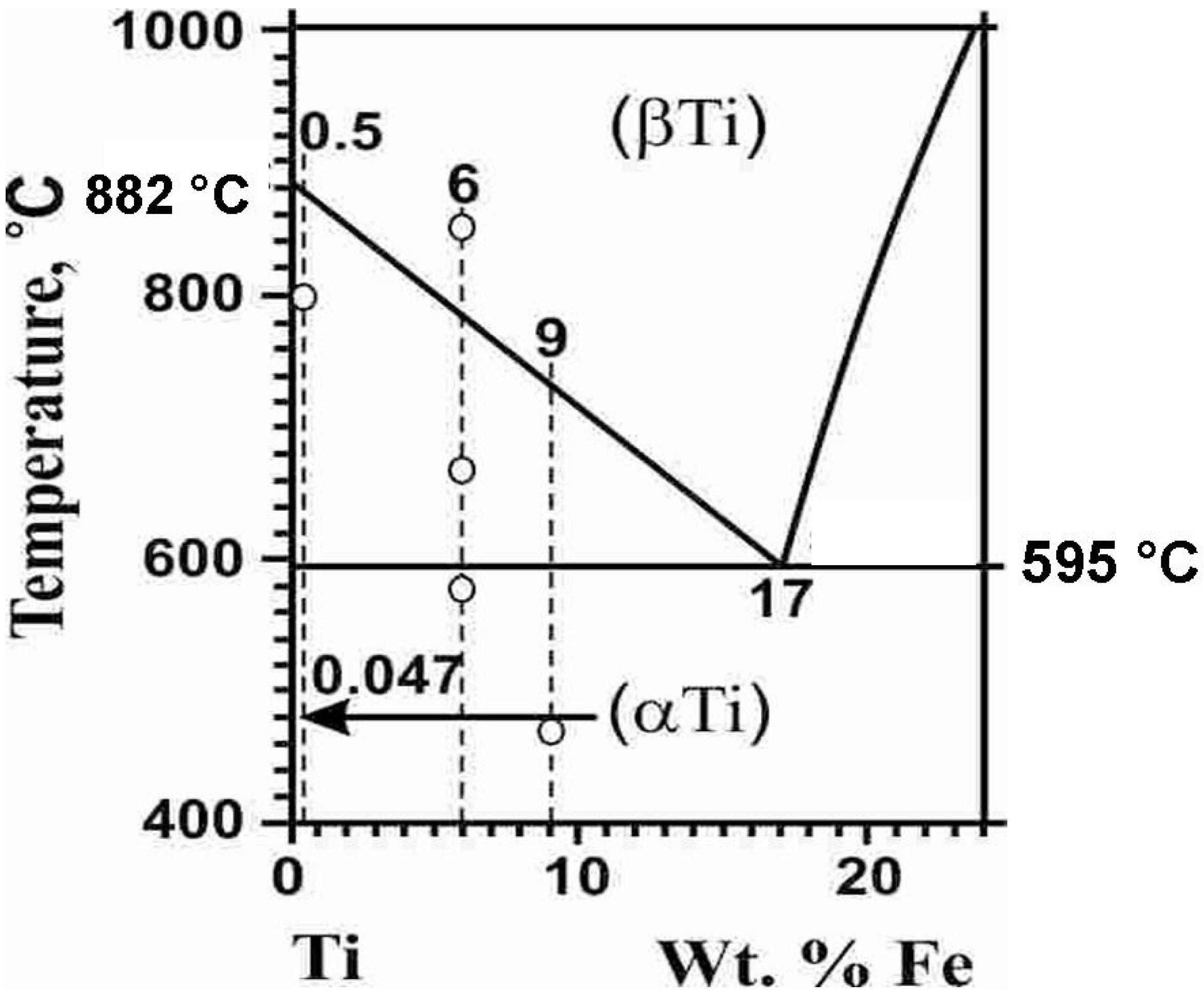
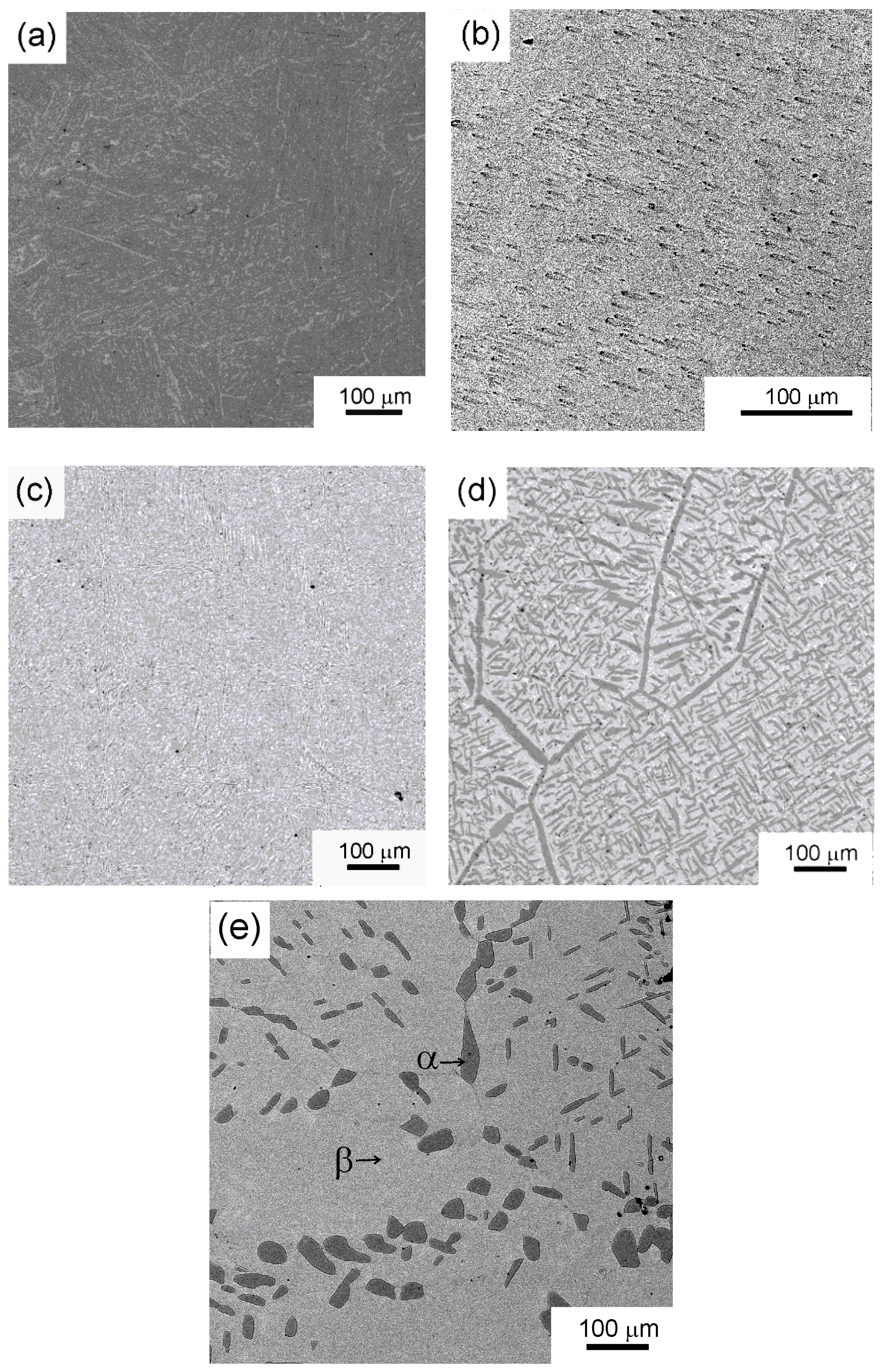
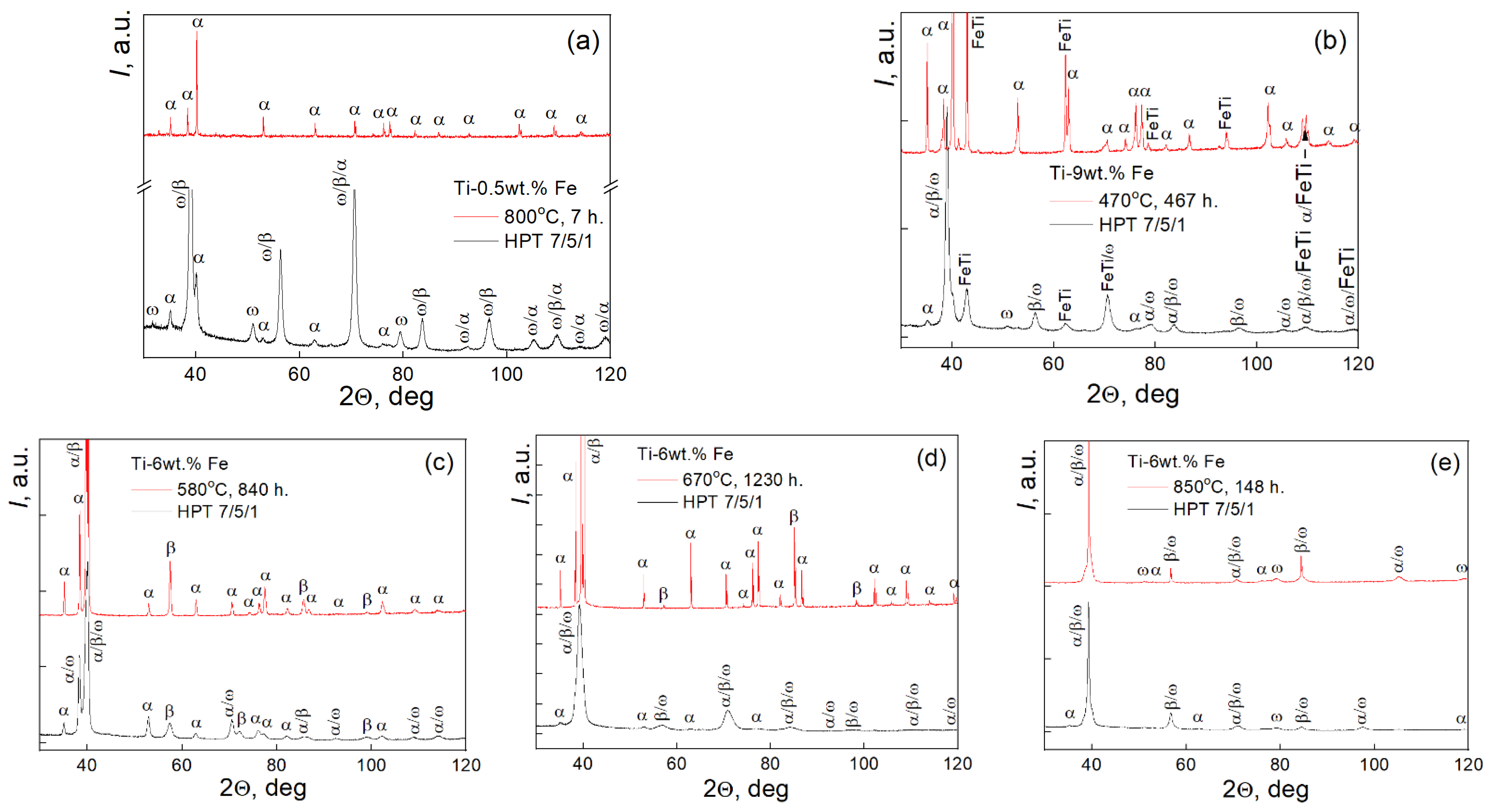
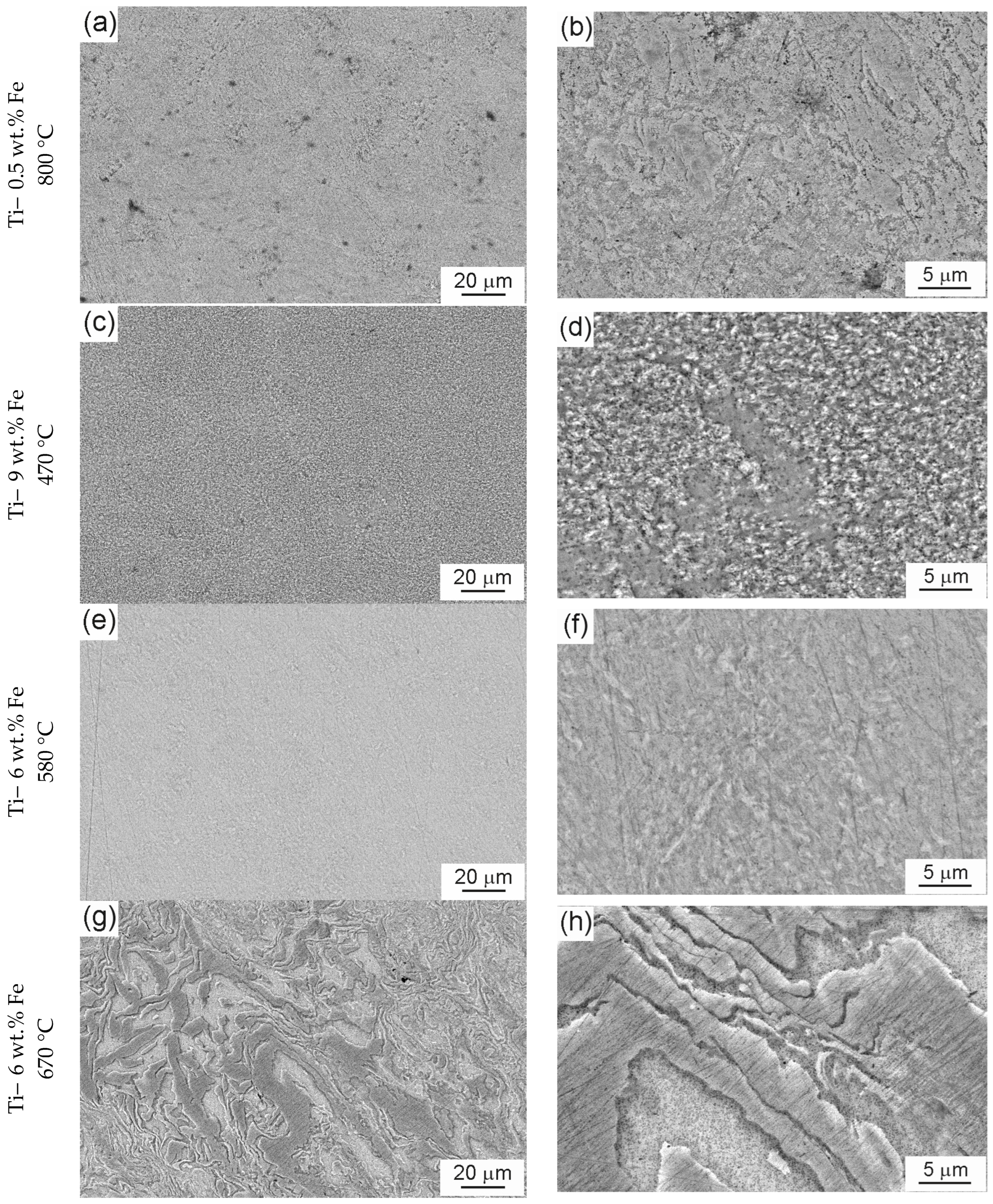




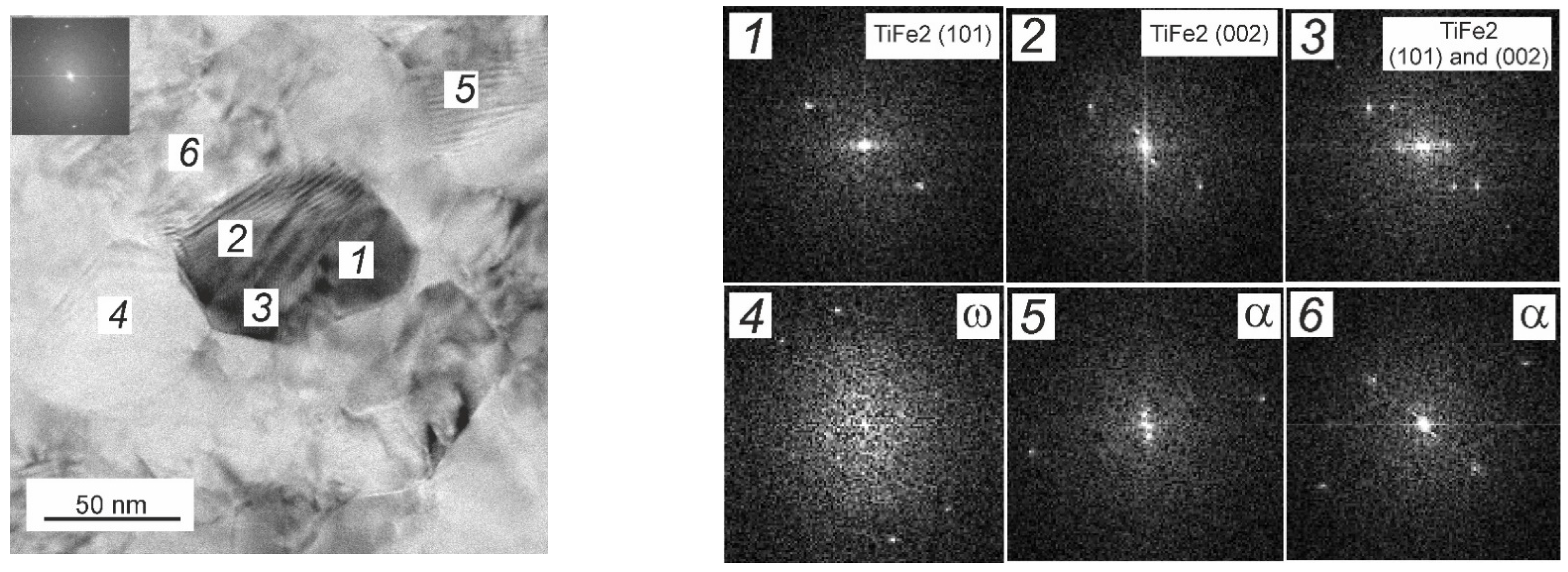

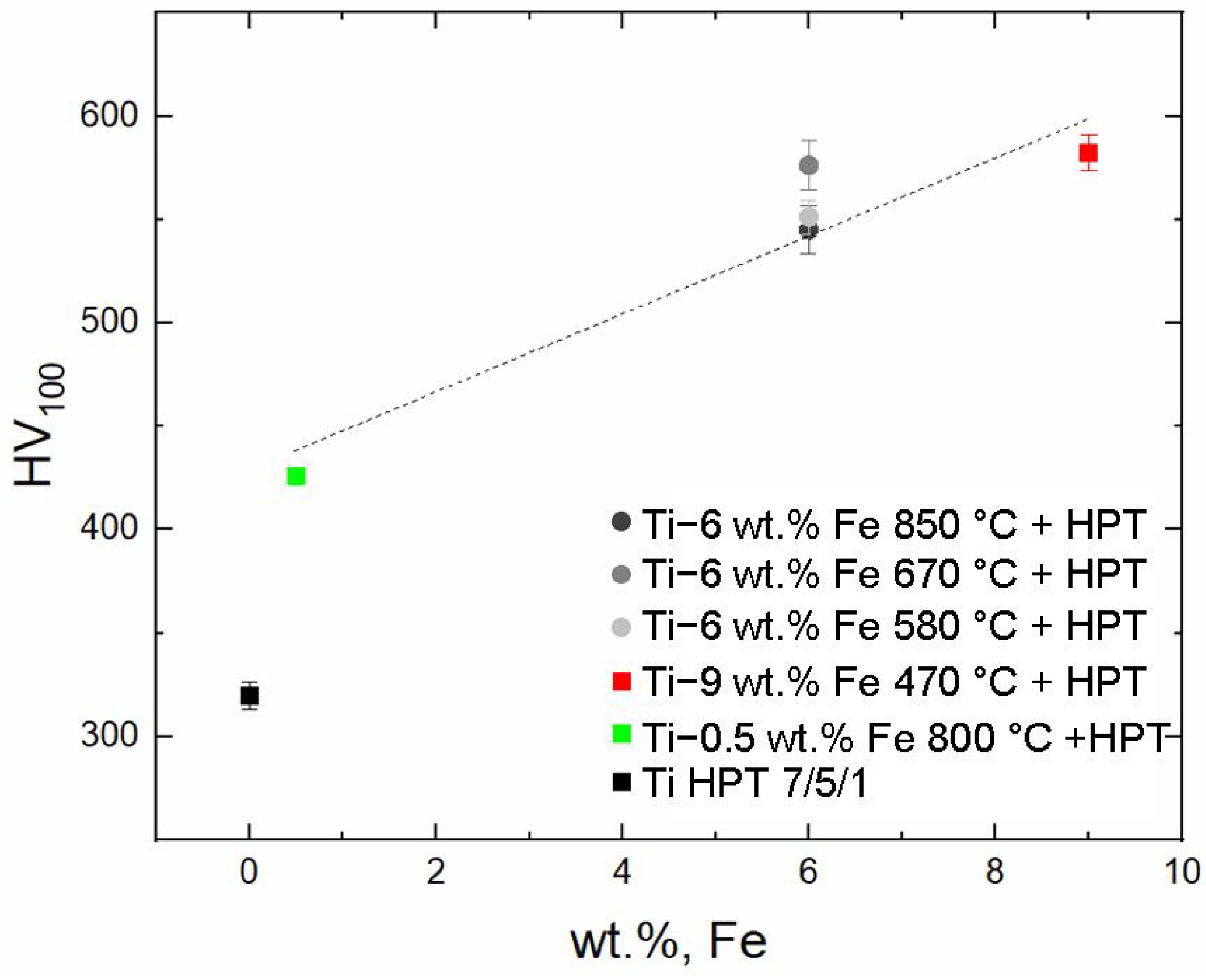
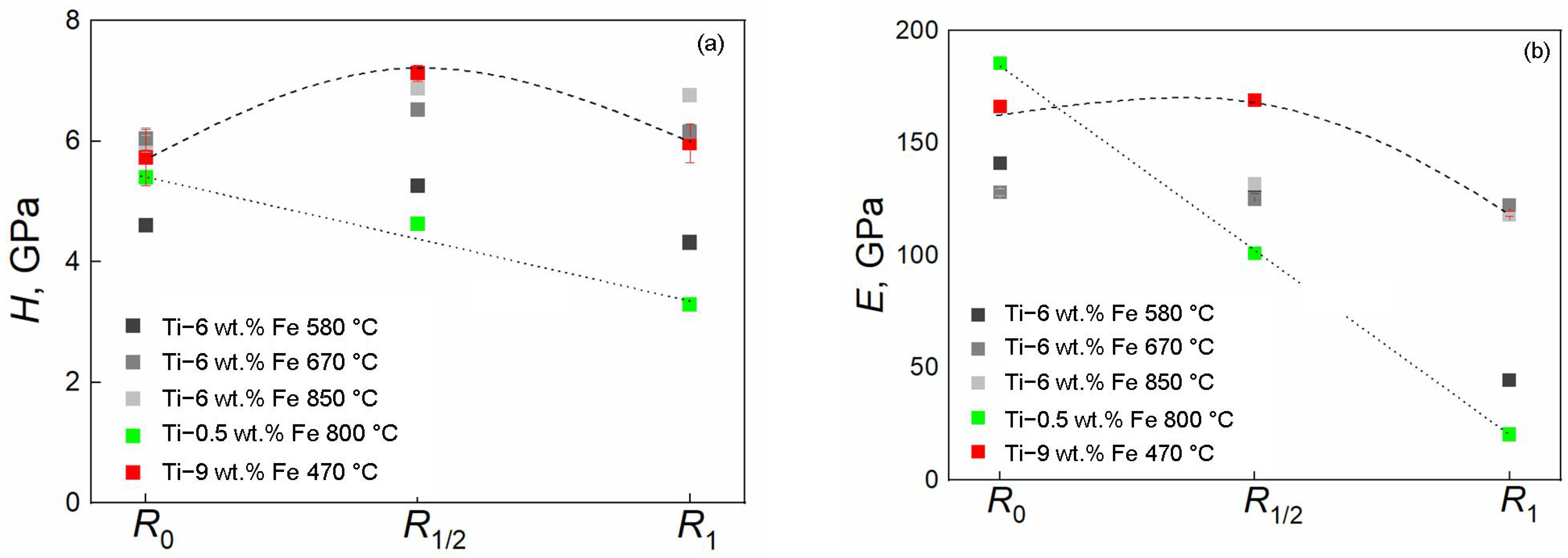


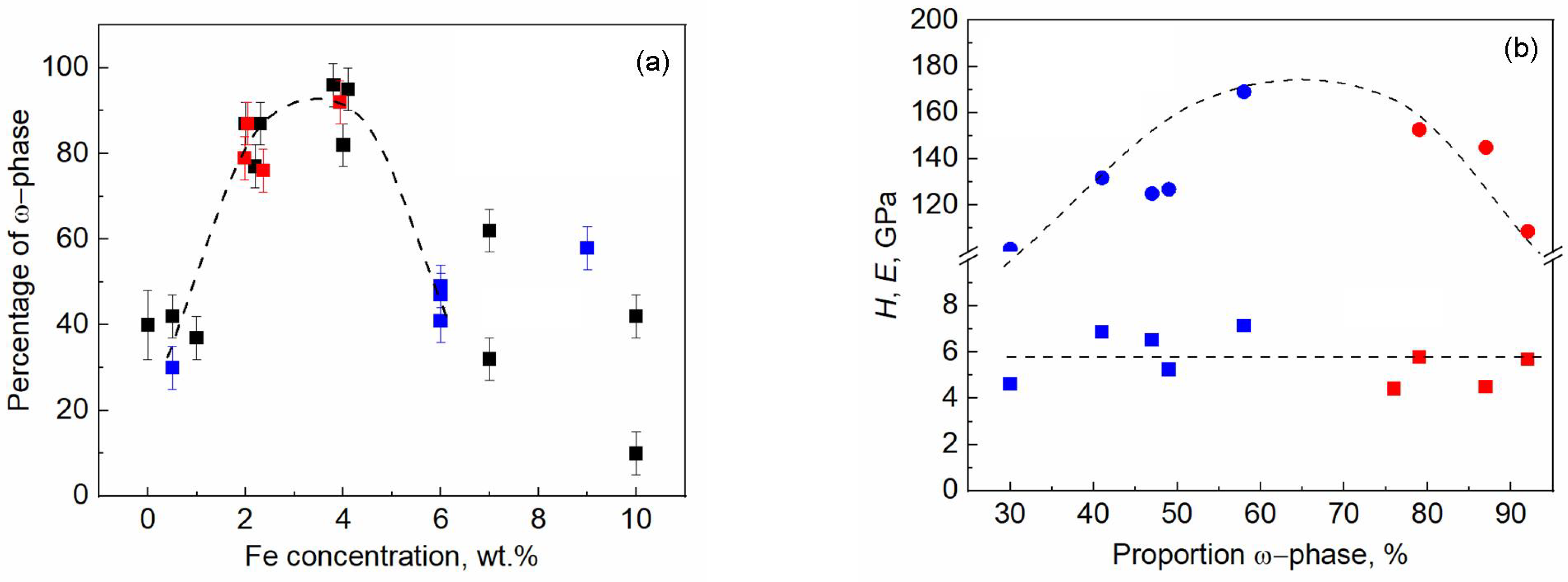
| Fe, wt.% | T, °C | αTi | βTi | ωTi | FeTi | ||||
|---|---|---|---|---|---|---|---|---|---|
| V, % | a, c, nm | V, % | a, nm | V, % | a, c, nm | V, % | a, nm | ||
| 0.5 | 800 | 100 | 0.2949; 0.4684 | - | - | - | - | - | - |
| 6 | 580 | 53 | 0.2949; 0.4685 | 47 | 0.3206 | - | - | - | - |
| 6 | 670 | 49 | 0.2950; 0.4686 | 51 | 0.3220 | - | - | - | - |
| 6 | 850 | 11 | 0.2950; 0.4686 | 79 | 0.3243 | 10 | 0.4626; 0.2813 | - | - |
| 9 | 470 | 84 | 0.2950; 0.4686 | - | - | - | - | 16 | 0.2976 |
| Fe, wt.% | T, °C | αTi | βTi | ωTi | FeTi | ||||
|---|---|---|---|---|---|---|---|---|---|
| V, % | a, c, nm | V, % | a, nm | V, % | a, c, nm | V, % | a, nm | ||
| 0.5 | 800 | 11 | 0.2949, 0.4686 | 59 | 0.3259 | 30 | 0.4628; 0.2821 | - | - |
| 6 | 580 | 20 | 0.2949, 0.4686 | 31 | 0.3210 | 49 | 0.4624; 0.2816 | - | - |
| 6 | 670 | 19 | 0.2949, 0.4686 | 34 | 0.3240 | 47 | 0.4628; 0.2816 | - | - |
| 6 | 850 | 14 | 0.2949, 0.4687 | 45 | 0.3239 | 41 | 0.4620; 0.2810 | - | - |
| 9 | 470 | 12 | 0.2951, 0.4683 | 18 | 0.3249 | 58 | 0.4631; 0.2821 | 12 | 0.2979 |
| Ti–0.5 wt.% Fe | Ti–6 wt.% Fe | Ti–9 wt.% Fe |
|---|---|---|
| α (100) | ω (001) | TiFe (100) |
| ω (101) | ω (101) | α (002) |
| TiFe2 (104) | β (200) | TiFe2 (200) |
| β (200) | TiFe2 (204) | TiFe2 (202) |
| TiFe2 (211) | α (112) | β (200) |
| β (211) | TiFe2 (220) | α (110) |
Disclaimer/Publisher’s Note: The statements, opinions and data contained in all publications are solely those of the individual author(s) and contributor(s) and not of MDPI and/or the editor(s). MDPI and/or the editor(s) disclaim responsibility for any injury to people or property resulting from any ideas, methods, instructions or products referred to in the content. |
© 2024 by the authors. Licensee MDPI, Basel, Switzerland. This article is an open access article distributed under the terms and conditions of the Creative Commons Attribution (CC BY) license (https://creativecommons.org/licenses/by/4.0/).
Share and Cite
Gornakova, A.S.; Straumal, B.B.; Tyurin, A.I.; Afonikova, N.S.; Kilmametov, A.R.; Druzhinin, A.V.; Nekrasov, A.N.; Davdian, G.S.; Duong, L.V. The Determining Influence of the Phase Composition on the Mechanical Properties of Titanium—Iron Alloys after High-Pressure Torsion. Materials 2024, 17, 3740. https://doi.org/10.3390/ma17153740
Gornakova AS, Straumal BB, Tyurin AI, Afonikova NS, Kilmametov AR, Druzhinin AV, Nekrasov AN, Davdian GS, Duong LV. The Determining Influence of the Phase Composition on the Mechanical Properties of Titanium—Iron Alloys after High-Pressure Torsion. Materials. 2024; 17(15):3740. https://doi.org/10.3390/ma17153740
Chicago/Turabian StyleGornakova, Alena S., Boris B. Straumal, Alexander I. Tyurin, Natalia S. Afonikova, Askar R. Kilmametov, Alexander V. Druzhinin, Aleksey N. Nekrasov, Gregory S. Davdian, and Luong V. Duong. 2024. "The Determining Influence of the Phase Composition on the Mechanical Properties of Titanium—Iron Alloys after High-Pressure Torsion" Materials 17, no. 15: 3740. https://doi.org/10.3390/ma17153740







